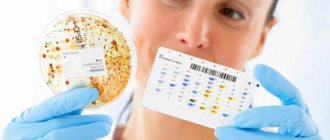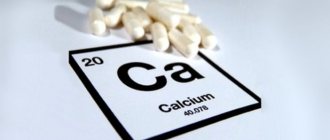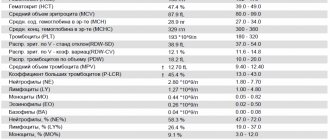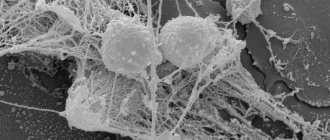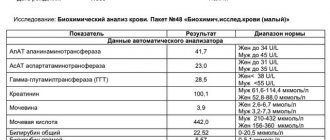Blood osmolarity (BOS) refers to the determination of plasma, since it contains osmotically active components in dissolved form. The term defines the complex of all dissolved kinetically active particles in one liter of plasma. This applies to cations, anions, and organically active substances. Osmotically active components include chlorine anions, sodium cations, and bicarbonate anion. These substances determine the osmotic activity of blood plasma. Ions can freely penetrate through the walls of capillaries and enter the vascular bed. They combine with water molecules and then transport them into the interstitial (intercellular) space.
Deviations from the norm
The blood osmolality test is of important diagnostic value, for example, in diabetes mellitus, since in this disease the osmolality of the blood usually increases.
In addition, such an analysis, which actually monitors the state of the blood plasma, can help select more accurate and successful treatment. Serum osmolality analysis is also performed to assess the level of sodium, urea, and glucose. Urea is one of the breakdown products of protein in the body. The osmolality test helps assess the water-salt balance of the patient's body. A doctor may order this blood test if he or she suspects that a patient is developing one of the following conditions:
- dehydration, dehydration,
- deficiency of sodium in the blood - hyponatremia,
- renal failure,
- poisoning with ethanol, ethylene glycol, methanol.
Blood is drawn from a vein, in the morning, on an empty stomach. Before taking the test, it is recommended not to eat for 6 hours, and not to drink any liquids other than clean water.
The normal values of osmolarity of biological fluids such as blood, or rather its serum (plasma), as well as cerebrospinal fluid (CSF), differ little, which cannot be said about urine, in which the norms for this parameter are 2 to 4 times higher.
Biological environmentNormal limits
| Blood plasma (serum) | 280 – 300 mOsm/l |
| Cerebrospinal fluid (CSF) | 270 – 290 mOsm/l |
| Urine (urine) | 600 – 1200 mOsm/l |
| IO (osmolarity index) | 2,0 – 3,5 |
| SWR (free water clearance) | (-1.2) – (-3.0) ml/min |
Numerical indicators of blood osmolarity in children, although not as significant, are still different from those in adults (Table 2). OSK (norm) in children begins to change starting from 9 months of age. By the age of one year it reaches 280 - 300 mOsm/l (the norm for an adult), remaining within these limits, regardless of the person’s age, until the end of life.
Child's ageNormal, mosm/l
| Newborns up to 1 week of life | 275 – 300 |
| Newborns from 1 week to 1 month of life | 276 – 305 |
| Children from 1 month to 1 year of life | 274 – 305 |
| Children from one year and older | 280 – 300 |
It should be noted that the above standards for adults and children may differ from those in other laboratories. In this regard, patients should first of all focus on the limits of normal values indicated in the analysis form of a particular laboratory.
The study of oncotic and osmotic pressure of blood plasma is very important for the examination and treatment of patients suffering from diabetes. This is explained by the fact that this disease is characterized by an excess of the osmolarity norm, so if several tests do not show a decrease in this indicator, the specialist should prescribe the patient another treatment.
The study of serum osmolarity is carried out in order to find out the quantitative indicator of urea, glucose and sodium. Urea is the result of protein breakdown in our body. The study of osmolality allows doctors to understand the state of water-salt balance in the body of the person being studied.
Dehydration
- Lack of sodium.
- Kidney failure.
- Poisoning from chemicals or gases.
Generally accepted medical standards for serum osmolality
| Unit | Non-pregnant adults | 1st trimester | 2nd trimester | 3rd trimester |
| mOsm/kg water | 274 – 296 | 273 – 282 | 278 – 291 | 276 – 285 |
| mmol/kg | 274 – 296 | 273 – 282 | 278 – 291 | 276 – 285 |
The formula is very simple: Osm = 1.86 Pa G M 10.
PA is a quantitative indicator of sodium.
G – glucose concentration.
M – urea index.
After conducting a series of studies, the laboratory issues a transcript that contains several indicators:
- Blood plasma osmolarity - normally this indicator varies from 280 to 300 mOsm/L.
- Urine osmolality – normal values are considered to be 50-1200 mOsm/kg.
- Osmotic window is the difference between the actual and theoretical osmolarity. Normally it does not exceed 6 mOsm/kg.
For convenience, the decoding is presented in the form of a table, where all the above indicators are entered and compared with the norm. The last column may indicate probable causes of deviations from the norms.
In addition to osmolarity, there is such an indicator as osmolality. It records the number of dissolved particles in the blood plasma indicated per 1 kg of blood. It is calculated using the following formula:
- Osm = 1.86 Pa G M 10, where
- Pa – sodium index;
- G – glucose;
- M – urea.
The normal value varies from 274 to 296 mOsm/kg of water.
In the case when there is an excess or deficiency of certain microelements in the blood plasma, we are talking about the presence of deviations. In this case, they can be of two types: hyperosmolarity and hypoosmolarity. Let's look at these states in more detail.
Hyperosmolarity, in which the normal level is exceeded, can develop in the following cases:
- Prolonged dehydration of various etiologies, including pathologies of absorption of liquids in the intestine.
- Bruises and mechanical damage to the membranes of the brain, which causes disruption of the hypothalamus.
- High blood glucose levels caused by poor diet and insufficient insulin synthesis.
- Rapid increase in sodium in blood plasma.
- Kidney diseases, in which harmful substances are not completely eliminated from the body.
- Intoxication with toxic substances, including food poisoning.
- Stroke of cerebral vessels, in which the normal nutrition of cells is disrupted.
Dehydration
The study of oncotic and osmotic pressure of blood plasma is very important for the examination and treatment of patients suffering from diabetes. This is explained by the fact that this disease is characterized by an excess of the osmolarity norm, so if several tests do not show a decrease in this indicator, the specialist should prescribe the patient another treatment.
The study of serum osmolarity is carried out in order to find out the quantitative indicator of urea, glucose and sodium. Urea is the result of protein breakdown in our body. The study of osmolality allows doctors to understand the state of water-salt balance in the body of the person being studied.
Dehydration
Generally accepted medical standards for serum osmolality
The formula is very simple: Osm = 1.86 Pa G M 10.
PA is a quantitative indicator of sodium.
G – glucose concentration.
M – urea index.
As a result of the studies, it was found that in intact rats OS was 6.6 ml/100 g of weight, after administering oxytocin to the animals - 4 ml/100 g of weight. Administration of oxytocin to rats caused a decrease in OS by 39.4%, a - (Table 1, Fig. 4).
Table 1
The volume of total water in the body of rats
| Experiment series | OB (ml/100 g weight) |
| Intact rats (Control) | 6,6 0,05 |
| Intact rats (Saline injection) | 6,6 0,02 |
| After administration of oxytocin | 4,0 0,1* |
* — Significance of differences compared to control
Rice. 1 Total water volume
table 2
Concentration of glucose and urea in rat blood plasma
| Experiment series | Glucose concentration (mmol/l) | Urea concentration (mmol/l) |
| Intact rats (Control) | 5,647 0,600 | 5,382 0,306 |
| Intact rats (Saline injection) | 5,647 0,600 | 5,382 0,306 |
| After administration of oxytocin | 6,829 0,367 | 12,571 0,920* |
Rice. 2 Glucose and urea concentration
Table 3
Sodium concentration and osmolality of rat blood plasma
| Experiment series | Sodium concentration (mmol/l) | Blood plasma osmolality (mOsm/kg) | |
| IN plasma | In red blood cells | ||
| Intact rats (Control) | 120,167 0,167 | 14,867 1,049 | 251,033 0,642 |
| Intact rats (Saline injection) | 101,667 1,667* | 11,367 0,033* | 210,5 0,526* |
| After administration of oxytocin | 131,485 5,702* | 6,806 2,054 | 265,93 10,660 |
Rice. 3 Sodium concentration and osmolality
CONCLUSIONS
1. We studied the literature on the research topic.
2. The volume of total water in the body of intact rats and after the administration of oxytocin was determined.
3. The concentration of glucose and urea in the blood plasma of intact rats and after the administration of oxytocin was determined.
4. The concentration of sodium in the blood plasma and erythrocytes of intact rats and after the administration of oxytocin was determined.
5. Determination of blood plasma osmolality in intact rats and after administration of oxytocin.
LIST OF SOURCES USED
1. Ametov A.S. // Diseases of the endocrine system / A.S. Ametov // Medicine. – 2006. – No. 3 – P. 52–56.
2. Anichkov N.N. The secretion of hormones from the pituitary gland and adrenal cortex is regulated by the central nervous system in accordance with the needs of the body / N.N. Anichkov // Physiological Journal of the USSR. - 1950. - No. 36. - P. 11-12.
3. Ashmarin I.P. Neurochemistry / I.P. Ashmarin // M.: IBKh RAMS. - 1996. - 469 p.
4. Baranov V.G. Guide to clinical endocrinology / V.G. Baranov // Medicine, 1977. - 664 p.
5. Berekhin E.B. Pharmacology of the kidneys and its physiological basis / E.B Berekhin // M.: Medetsina, 1979. - P. - 23 - 48.
6. Berezov T.T. Biological chemistry/ T.T. Berezov, B.F. Korovkin // M: Medicine, 1990. - 528 p.
7. Berezov T. T. Biological chemistry / T. T. Berezov, B.F. Korovkin // - M "Medicine", 1990. - P. 56 - 83.
8. Brown F. Comparative physiology of animals / F. Brown F // trans. from English, M, 1967. P. 49 – 85.
9. Bykov K.M. Cerebral cortex and internal organs / K.M. Bykov // - M, “Medicine”, 1945. - 362 p.
10. Vaido A.I. Comparative genetic analysis of the excitability of the nervous system / A.I. Vaido, Yu.S. Dmitriev // Genetics, 1983. - No. 19 - S. - 54-103.
11. Vander A. Physiology of the kidneys / A. Vander // M.: Medetsina, 2000. - P. - 4 - 33.
If osmolality is increased, what does this mean?
Blood osmolality is considered elevated if it exceeds 295 milliosmoles per kg of blood. It can occur as a result of the following pathological conditions:
- dehydration of the body,
- diabetes insipidus,
- various head injuries,
- stroke,
- elevated glucose levels – hyperglycemia,
- increased concentration of sodium in the blood - hypernatremia,
- uremia – a condition in which the kidneys cannot cope with the removal of harmful substances from the body, resulting in intoxication,
- poisoning with ethanol, methanol or ethylene glycol.
If the blood osmolality rate decreases and falls below 275 milliosmoles per kg of blood, it is considered abnormally low. This condition may be due to several reasons:
- excessive fluid intake - overhydration,
- decreased sodium concentration in the blood – hyponatremia,
- paraneoplastic syndrome caused by a malignant tumor,
- Parhon's syndrome is a syndrome of inadequate secretion of antidiuretic hormone.
Some of these reasons are more serious, others less so. After receiving the test results, the doctor must compare them with the results of other studies, make an accurate diagnosis and prescribe appropriate treatment.
Osmolality
Osmolality is a measure of the concentration of a solution (expressed in osmoles), which is determined by the amount of solute per kilogram of solvent or solution itself. Osmolality is measured directly using an osmometer or calculated using a formula. An osmol is the molecular weight of a substance divided by the number of ions or particles that form when the substance dissolves. Osmolarity is a measure of the concentration of a solution (expressed in osmoles), which is determined by the amount of solute in a liter of solution or a property of the solution that depends on the concentration of the solute in the total volume of the solvent.
Osmolality below acceptable values
Sodium cations and other osmotically active substances create osmotic pressure (OP) in the water spaces of the body.
Sodium is an extracellular cation (Na), an increase in its concentration in plasma will in any case lead to an increase in OD. This will stimulate the drinking center (thirst center) and increase the production of antidiuretic hormone (ADH) - vasopressin. The effect of vasopressin on the V2 receptors of the renal tubules will increase the reabsorption of water and its retention in the body.
With a decrease in the content of this extracellular cation, the opposite effect can be expected: the drinking center is suppressed, the production of antidiuretic hormone decreases, and urination increases. Such changes in one direction or another in the concentration of sodium ions usually (with the exception of certain cases) occur in parallel with fluctuations in the values of blood plasma osmolarity.
If the analysis transcript shows a figure below 272 mOsm/kg, the patient is diagnosed with a pathologically low concentration of osmolality - hypoosmolarity. It can be triggered by:
- Drinking huge amounts of liquid.
- Reduced sodium concentration.
- Paraneoplastic syndrome caused by malignant neoplasm.
- Parhon's syndrome (impaired secretion of antidiuretic substances).
There are several types of this condition.
Isotonic
It is distinguished by the gradual loss of water and salts from intracellular spaces. The hemoconcentration indicator is somewhat elevated, the sodium level and serum osmolarity are normal. Therapeutic measures involve the use of:
- Mr. Ringer.
- Normosalts.
- Trisoli.
- Hlosoli.
- Acenosols.
- Glucose-salt mixtures.
The volume of one dose of each medication is calculated in detail using formulas.
Hypertensive
A distinctive feature is that water leaves our body faster than salt. Initially, this occurs in the vessels, then in the cells. An increase in hemoglobin, protein and hematocrit is observed.
Treatment of the deviation involves the use of sodium chloride solution and a glucose-insulin mixture. All this is administered intravenously. The glucose mixture is calculated individually for each patient.
Hypotonic
It is considered the most difficult variety. Because of it, extracellular hypohydration occurs, laboratory tests record a rapid drop in chlorine and sodium. These changes provoke oversaturation of cells with water. The concentration of hematocrit, protein and hemoglobin reaches a critical level.
Treatment of pathology involves the use of isotonic and hypertonic solutions. Glucose is strictly prohibited. When calculating the dose, the specialist takes into account sodium levels, the patient’s weight and the amount of intracellular fluid.
Osmolar difference
This is the difference between calculated and measured osmolarity; in healthy individuals it is 10
When intravascular water content decreases:
- hyperlipidemia (lipemia is recorded);
- hyperproteinemia (total protein > 10 g/dl)
Increase in the number of medium molecules in serum (measured osmolality may be > 300 mOsmol/kg water)
- Ethanol; a very high osmolar difference and a low blood ethanol level indicate the circulation of another medium-molecular toxin, such as methanol.
- Methanol.
- Isopropyl alcohol.
- Mannitol (monitor mannitol retention after transfusion).
- Ethylene glycol, acetone, ketoacidosis, and paraldehydes in doses close to lethal do not significantly increase the osmolar difference.
- Extremely severe conditions, especially shock, accompanied by acidosis (lactic acidosis, ketoacidosis, etc.).
Osmolality exceeds standard value
Thus, osmolarity of blood (plasma or serum) is an important parameter indicating the preservation or disorder of the dynamic balance of water in the body. It is measured using special laboratory equipment or calculated using a formula after carrying out the necessary biochemical tests (sodium, urea, glucose).
In addition to the described object of study (osmolarity), the table above shows other laboratory tests: free water clearance (SWR - a rather sensitive and important indicator of the concentrating ability of the kidneys) and osmolarity index (IO - the ratio of urine osmolarity to blood plasma). They are directly related to determining the functional abilities of the kidneys during the development of acute renal failure (ARF) and are also calculated using formulas.
For example, 287 mOsm/kg – 284 mOsm/kg = 3 mOsm/kg (corresponds to the norm). If the osmotic window is more than 6 but less than 10 mOsm/L, then doctors suspect the development of keto-, lactate- or renal acidosis. If the level of this indicator crosses 10 mOsm/l and tends to increase, then there is reason to think about severe poisoning (ethyl or methyl alcohol, as well as other organic substances that can affect OSC).
A critical increase in serum osmolality is considered to be 298 mOsm/kg. This deviation is called hyperosmolarity. It can be provided by the following factors:
- Severe dehydration of the body.
- Diabetes insipidus.
- Mechanical head bruises.
- Strokes.
- Increased glucose levels.
- An increase in sodium concentration in the body.
- The inability of the kidneys to fully remove harmful toxins from the human body, which over time leads to the development of intoxication.
- Carbon monoxide poisoning and household chemicals.
Stroke
There are three types of hyperosmolarity conditions.
Isotonic
It is characterized by excessive accumulation of salt and water in the body, which provokes the development of heart and kidney diseases. Treatment of the deviation involves the patient taking cardiac glycosides and minimally drinking water. Pharmacological agents are prescribed:
- Furosemide.
- Prednisolone.
- Triamterene.
Hypertensive
It is characterized by the accumulation of water and salts in blood vessels and intercellular membranes, causing low hemoglobin, protein and hematocrit. Therapeutic measures include:
- A solution of insulin and glucose.
- Albumen.
- Lasix.
- Veroshpiron.
Hypotonic
Accumulation of fluid in blood vessels, in the cell and its membranes. Because of this, sodium, protein and hemoglobin drop sharply in the body. Therapy involves the use of mannitol solution, hypertonic mixtures and corticosteroids. To accelerate fluid removal, hemodialysis with ultrafiltration mode is performed.
Stroke
Stroke
Help of osmometry and osmolarity calculation in diagnosis and treatment
Determining the osmolarity of blood and urine, calculating the osmolarity index and free water clearance using the formula are by no means simple studies. Various methods of osmometry (method of increasing the boiling point, method of depression of the freezing point) are not used by every medical institution and are complex laboratory tests.
However, in medicine, blood osmolarity is considered an important diagnostic criterion, since this indicator allows one to establish a number of pathological conditions or even predict them (the development of acute renal failure) when classical indicators do not yet respond. Obviously, this primarily concerns severe kidney diseases.
The concentrations of creatinine and urea studied in such situations will change only after some time (AKI - from 3 to 4 days), when half of the structural units of the kidney involved in the production of urine (nephrons) fail and will not be able to fulfill their functional purpose. Determination of plasma and urine osmolarity, osmolarity index and free water clearance will make it possible to predict and/or detect the development of acute renal failure already on days 1–2.
Thus, this indicator will be applied and will assist in diagnosis:
- Acute renal failure at the earliest stage of formation;
- Hypoosmotic syndromes (a drop in the level of the indicator below 280 mOsm/l), accompanied by a number of nonspecific symptoms: headache, fatigue, lethargy, nausea, causeless vomiting;
- Hyperosmotic syndromes (an increase in the numerical values of osmolarity - above 350 mOsm/l), which most often create conditions for the development of comatose states in diabetes mellitus (diabetes mellitus);
- Causes of hyponatremia (decreased concentration of sodium cations – ↓Na);
- Hypernatremia (increased content of sodium cations – Na);
- Pseudohyponatremia, caused by an increase in the concentration of fats (hypertriglyceridemia) and proteins (hyperproteinemia), the molecules of which are larger in size than sodium molecules and do not affect changes in blood osmolarity;
- TUR syndrome (water intoxication syndrome, as a complication of certain operations, for example, resection of the prostate gland);
- Diabetes insipidus (diabetes insipidus), diabetes mellitus (hyperglycemic conditions, diabetic ketoacidosis);
- Poisoning with toxic substances that also belong to the group of osmotically active substances (ethanol, methanol, ketone bodies, lactate, ethylene glycol, etc.);
- Acute increase in intracranial pressure (intracranial hypertension - ICH).
In addition, this laboratory test will help in the treatment of diseases requiring transfusion and infusion measures (assessment of the effectiveness of therapy), as well as hypoosmolar overhydration and coma, accompanied by an increase in blood plasma osmolarity.
What does the analysis show?
How to understand the tests you receive? This is probably possible if you try to follow the guidelines below:
- It is known that changes in blood plasma osmolarity parallel fluctuations in the content of sodium cations in it. Consequently, an increase in Na concentration (hypernatremia) and an increase in TSC (more than 290 mOsm/l) will lead to an increase in the activity of the drinking center, the person will not leave the feeling of thirst, and stimulation of vasopressin synthesis will begin to prevent the removal of water resources from the body. An increase in blood plasma osmolarity by 50–60 mOsm/L is a dangerous sign, since in this situation the patient may die from cerebral edema.
- And, conversely, a decrease in Na levels (hyponatremia) and a decrease in TSC (below 280 mOsm/l), inhibiting the production of vasopressin, promotes increased release of water from the body through the kidneys.
Meanwhile, everything is not so simple, since, focusing on sodium concentration, you can encounter paradoxical situations that should be taken into account, for example: sodium in the blood and TSC decrease, and urine osmolarity increases. At the same time, an increase in Na content is noted in overly concentrated urine. Such circumstances may be due to the influence of such an etiological factor as SIADH (syndrome of inappropriate secretion of antidiuretic hormone), in which the production of ADH does not depend on how much the body needs water.
And it turns out that to complete the picture indicating the state of the body, it is necessary to determine the amount of sodium in the blood and urine, as well as carry out an analysis of the osmolarity of these biological media. In addition, the analysis form must contain such indicators as blood sugar (hyperglycemia increases TBC) and urea.
Of course, there are other examples of discrepancies between some indicators, but this information can only confuse the patient. And we are talking only about blood osmolarity...
Analysis value
To obtain the correct result, the following conditions must be met:
- do not drink alcohol for two weeks before taking the test;
- maintain normal drinking regime;
- eat right (exclude dishes that overload the gastrointestinal tract);
- dress appropriately for weather conditions to avoid hypothermia and overheating;
- On the eve of the test, you should get at least eight hours of sleep at night.
OSC can change under the influence of the following factors:
- food before taking the test;
- use of medications, dietary supplements;
- non-compliance with dietary recommendations;
- donation of blood and its components;
- drinking alcoholic beverages.
To understand the result of a laboratory test, you can use the following guidelines:
- The change in TSC is combined with a violation of the concentration of sodium cations. Increasing sodium levels, OSA stimulates the activity of the drinking center. A person becomes thirsty. Increased vasopressin production prevents the removal of water from tissues. If the TSC indicator increases by 55-65 units, there is a high probability of developing cerebral edema and death of the patient.
- A decrease in sodium concentration, OSA inhibits the synthesis of vasopressin. The kidneys begin to actively remove water from the body.
But this knowledge is not always enough. There are clinical situations when sodium concentration is reduced, blood osmolarity and urine osmolality are increased. Urine becomes concentrated and has a high sodium content. This is caused by a syndrome characterized by inappropriate production of antidiuretic hormone. Its synthesis is determined not by the body’s need for water, but by the influence of other factors.
Specifics of the study
The study of plasma osmolarity is characterized by the content of chemical substances in it. To carry out the event, the laboratory assistant takes venous blood from the patient.
Several basic values are assessed, which are studied by specialists in the resulting material. After the examination and grouping of the necessary data is completed, laboratory assistants enter the obtained indicators into a special correspondence table, with the help of which acceptable values and their violations are later displayed.
Checking the osmotic concentration is determined by the following factors:
- To obtain information about the amount of fluid in the blood.
- As a source of indicators of the chemical composition of serum.
- To monitor increases and decreases in serum fluid concentrations.
- To check the level of the hormone that is responsible for fluid retention in the body;
- To detect the underlying causes of dehydration and swelling of the extremities.
- To diagnose the body for the presence of pathological processes.
- To diagnose the presence of poisons, methanol and other dangerous substances.
The study of plasma osmolarity is characterized by the content of chemical substances in it. To carry out the event, the laboratory assistant takes venous blood from the patient.
Several basic values are assessed, which are studied by specialists in the resulting material. After the examination and grouping of the necessary data is completed, laboratory assistants enter the obtained indicators into a special correspondence table, with the help of which acceptable values and their violations are later displayed.
Features of osmolarity
An increased blood osmolarity provokes a decreased urine osmolarity. This imbalance is the main symptom of abnormalities in the renal parenchyma. The slightest violation of this norm is provoked by the processes that are responsible for the distribution of fluid in the body.
According to basic physiology, a person needs to consume 1-2 liters of water daily for normal existence, since it enriches the body with useful substances and microelements. Most of them enter us through drinking, the rest through liquid found in food. Unnecessary or waste water is removed from the body by the epidermis, pulmonary, intestinal and renal systems. The daily rate of fluid excreted in urine and feces is 0.8 - 1 liter.
Read also: Norms of blast cells in a blood test, diagnosis and interpretation of results
If a person’s water balance is disturbed, or fluid is not properly removed from the body, the osmolarity of blood and urine is disrupted. An excess of fluid provokes swelling and heaviness in the limbs, and a lack of it will cause severe dehydration and plasma viscosity.
More than 30 percent of serious diseases develop due to impaired water balance. For example, excess fluid and electrolyte imbalance in most cases cause:
- Kidney diseases.
- Cardiac pathologies.
- Blood diseases.
- Circulatory disorders.
Fluid deficiency provokes the following changes in the body:
- Excess glucose in the blood.
- Diseases of the adrenal glands and kidneys.
- Diabetes.
Thanks to osmolarity analysis, it is easier for a specialist to determine the state of water-salt balance and, if necessary, correct it with medications.
Preparing for the test
Plasma osmolarity testing is very complex because it can be influenced by many factors. To avoid repeated collection of material and not waste time, specialists insist that the patient undergo special preparation. Despite its importance, it is very simple.
First of all, the patient must tell the doctor about all the medications he is currently taking. He is obliged to listen carefully to the patient and determine whether it is possible to continue taking pharmaceuticals or whether it is better to temporarily stop so as not to affect the result of the analysis.
The second thing you need to point out to your doctor is taking dietary supplements, since they can also affect the interpretation of the study.
Important! Blood for plasma osmolarity is donated only on an empty stomach, so the patient is prohibited from taking any food or drinks 9 hours before collecting the material.
Prohibited the day before the study:
- Smoking.
- Drink alcohol.
- There are flour products.
Flour products
- Abuse sweet foods.
Sweets
Experts advise eating “light” steamed food a few days before collecting whey.
If a patient regularly participates in donor programs, he can take an osmolarity test only 15-18 days after the last donor collection or blood transfusion. This pause is needed for the body to recover and correctly show its condition.
The collection of biomaterial occurs quickly and does not cause discomfort or pain to the patient. Over many years of medical practice, no complications were recorded after the test. Only in some patients did a small bruise or swelling form at the site of needle penetration. As a rule, everything went away within 2-3 days.
Plasma osmolarity testing is very complex because it can be influenced by many factors. To avoid repeated collection of material and not waste time, specialists insist that the patient undergo special preparation. Despite its importance, it is very simple.
First of all, the patient must tell the doctor about all the medications he is currently taking. He is obliged to listen carefully to the patient and determine whether it is possible to continue taking pharmaceuticals or whether it is better to temporarily stop so as not to affect the result of the analysis.
The second thing you need to point out to your doctor is taking dietary supplements, since they can also affect the interpretation of the study.
PastriesSweets
Experts advise eating “light” steamed food a few days before collecting whey.
If a patient regularly participates in donor programs, he can take an osmolarity test only 15-18 days after the last donor collection or blood transfusion. This pause is needed for the body to recover and correctly show its condition.
The collection of biomaterial occurs quickly and does not cause discomfort or pain to the patient. Over many years of medical practice, no complications were recorded after the test. Only in some patients did a small bruise or swelling form at the site of needle penetration. As a rule, everything went away within 2-3 days.
PastriesSweets
4.What are the risks and what could interfere with the analysis?
What are the risks of an osmolarity blood test?
Possible risks can only be associated with the blood collection itself. In particular, the appearance of bruises at the puncture site and inflammation of a vein or artery (phlebitis). Warm compresses several times a day will relieve phlebitis. If you are taking blood thinning medications, you may bleed at the puncture site.
What can change blood osmolarity?
Plasma osmolarity may change due to:
- Drinking alcohol before the test;
- Recent blood transfusion.
Determination of the osmotic window
1.86× N M G 9, where
N – sodium concentration in plasma;
M – urea level;
G – glucose content.
All these microelements are calculated additionally.
Next, the results obtained are substituted into the basic formula: Actual Osm - Theoretical Osm. The end result is the osmotic window.
1.86× N M G 9, where
Checking this indicator will not be easy even for an experienced laboratory technician. Such a study makes it possible to identify the initial stages of many deviations and pathologies. As a rule, the value of blood plasma osmolality is characterized by an increase or decrease in general norms. Various factors can provoke deviations.
Important! Blood plasma osmolarity is normal only if there are no even minimal violations of generally accepted values.
Blood plasma osmolarity
In medicine, there are two types of blood osmolarity disorders - hyperosmolarity and hypoosmolarity. Hyperosmolarity refers to a high concentration of active particles, and hypoosmolarity refers to a too low level of active particles.
If blood biochemistry shows a low osmolarity concentration, then the patient expresses this:
- Severe weakness.
- Unreasonably rapid fatigue.
- Systematic attacks of nausea.
- Vomiting.
- Drowsiness.
Gagging The
following manifestations are typical for hyperosmolarity:
- Numerous pathological reflexes.
- Decreased concentration.
- Depression and apathy towards what is happening.
- Rare urination.
- Disruption of the facial nerves.
- Impaired swallowing and chewing reflexes.
- Low body temperature.
- Unreasonably damp skin.
Wet skin
To put it simply, osmolarity is the concept of how thick or thin the blood is. Any deviations from the norm are harbingers of serious diseases or pathological changes in the body.
To carry out the analysis, a specialist requires blood plasma. Such studies in most cases provide insight into the health status of a person suffering from diabetes. This is due to the fact that diabetes provokes “thickening” of the blood, which, in turn, affects increased osmolarity levels.
This study also helps to select the most appropriate therapy for numerous diseases, monitor its results, and prevent the development of complications and side effects.
Application
Diagnosis of non-ketotic hyperglycemic coma. Control of water-electrolyte balance
- Identify abnormal serum water levels to evaluate for hyponatremia
- Measurements of plasma and/or urine osmolality are more valuable in assessing hydration status than changes in hematocrit, urea, or plasma proteins, as they depend on many other factors.
Promotion
Diabetic ketoacidosis (osmolality should be determined constantly in decompensated diabetes mellitus).
Non-ketotic hyperglycemic coma.
Hypernatremia with dehydration
- Diarrhea, vomiting, fever, hyperventilation, inadequate water intake.
- Diabetes insipidus is central.
- Nephrogenic diabetes insipidus - congenital or acquired (hypercalcemia, hypokalemia, chronic kidney disease, sickle cell anemia, effects of certain medications).
- Osmotic diuresis - hyperlycemia, administration of mannitol.
Hypernatremia with normal hydration - occurs when the hypothalamus is damaged.
- Impaired sensitivity of osmoreceptors (primary hypernatremia) - water load does not lead to normalization of osmolarity; Chlorpropamide may lower sodium levels to near normal levels.
- Impaired thirst (hypodipsia) - drinking water quickly returns sodium levels to normal.
Hypernatremia with overhydration is iatrogenic and accidental (eg, children being fed high-sodium diets and water, or CPR with soda). Drinking alcohol; alcoholic coma with hyperosmolar status. Decreased (equivalent to hyponatremia) Hyponatremia with hypovolemia (urine sodium typically >20 mEq/L)
- Adrenal insufficiency (for example, congenital forms of adrenal hyper- and hypoplasia with sodium loss, adrenal hemorrhage, inadequate corticosteroid therapy).
- Renal losses (osmotic diuresis, proximal renal tubular acidosis, sodium-losing nephropathies, pyelonephritis, diseases of the renal medulla, polycystic kidney disease).
- Losses through the gastrointestinal tract (diarrhea, vomiting).
- Other losses (burns, peritonitis, pancreatitis).
Hyponatremia with normal volume or hypervolemia (dilution syndrome)
- Congestive heart failure, liver cirrhosis, nephrotic syndrome.
- SNS ADH.
Formulas for calculating and predicting serum osmolality (do not compete with direct osmolality measurement):
mOsmol/L = (1.86 x serum Na) + (serum glucose: 18) + (BUN: 28) + 9 (in mg/dL)
in SI units: = (1.86 x serum Na) + serum glucose (mmol/l) + BUN (mmol/l) + 9
Na + + K + 4- (BUN: 28) + (glucose: 18). But since there is relatively little potassium in the serum, and the level of urea has little effect on the distribution of water, the formula is further simplified: 2Na + + (glucose /18).
